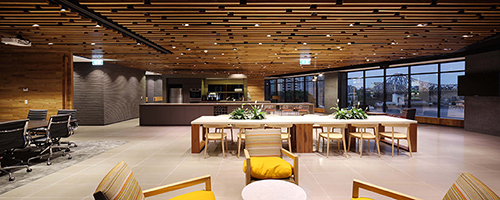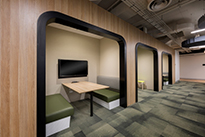How to make activity-based working drive your culture of innovation
 By Peter Marix-Evans >>
By Peter Marix-Evans >>
ACTIVITY-BASED working (ABW) has moved from workplace experiment to corporate standard in just a few years. But if you’re looking around your office and wondering why the shift hasn’t delivered on its promise – it might be because you’re doing it wrong.
Research found nearly two-third of companies plan to adopt a shared-desk workplace strategy by 2020, an increase of 30 percent. In addition to saving space and reducing commercial overheads, businesses are looking to transform their culture with a new way of working.
By its very nature, ABW is a design-led approach, allocating different types of spaces to suit business need. For example, if collaboration is a key aspect of your commercial success, dedicating spaces for people to come together makes sense.
It’s also driven by the need for greater innovation in the face of increasingly global and digital competition. ABW sets out to foster better collaboration and harness diversity of thought, increasing the likelihood of finding innovative solutions to business problems. 
Sounds great, right? But when it fails, ABW becomes a major source of frustration for employees, hindering their ability to get work done and, at worst, giving them a reason to leave.
A growing number of studies and horror stories are shedding light on the impact of getting an ABW strategy wrong.
If you’re implementing an ABW strategy or have one in place already, how do you ensure yours is a catalyst for transformation and not a reason for your staff to leave?
SURE YOU’RE NOT HOT DESKING?
One common issue is that businesses with ABW plans end up hot-desking instead. One is based on design principles to improve working conditions; the other is focused on using real estate more effectively.
ABW is about creating a workspace to suit the type of work activity. For some people this could be collaboration spaces, for others it’s about regular access to a computer with multiple screens.
Hot-desking and ABW are not mutually exclusive – it makes sense for some staff to swap desks based on the activity they’re currently working on.
But it becomes a problem when all staff are expected to adopt a hot-desking approach, regardless of whether it makes sense for their work. Rather than motivating your employees, this often has the opposite effect.
Ensuring you’re not forcing employees to move around your office for the sake of it is key to a successful ABW strategy.
DO STAFF HAVE A CHOICE FOR WORKSPACE?
Your staff are not a homogenous group. While some thrive in noisy, vibrant workspaces, others are happiest with a desk of their own in a quiet area of the office.
Ensuring the flexibility for staff to work in a way that best suits them is critically important.
This means having a workspace designed specifically for the type of activities your staff requires, including collaboration spaces, breakout rooms, quiet areas and relaxation stations. Ensuring people have a choice about where they’re working has a big boost on productivity.
With technology providing us the tools to work from anywhere, staff don’t always need to commute to the office to get things done either.
Providing the flexibility to work from home, the café or the local park is good for productivity and will also help with staff retention.
IS CULTURE AN ENABLING FORCE FOR ABW?
ABW is not only a driver of culture – it’s impacted by it too. There’s no point in having a fantastic setup for a raft of different working styles only for your staff to be too scared to use them. 
This is where culture is key. Business that are focused on output rather than presence have a far greater chance of successfully implementing an ABW office.
The right culture allows people to work in a way that suits their activity and their personality. A constructive culture is key to any workplace transformation and ABW is no exception.
When done well, ABW is a fantastic driver of business culture. It boosts productivity, improves collaboration and drives a more innovative approach to business problems.
But it only works if it’s designed to add value, rather than to cut costs.
This means ensuring it’s designed and built to meet the needs of your staff.
Peter Marix-Evans is the CEO at SHAPE Australia, a commercial fitout and refurbishment specialist known for its innovation, needs interpretation, and delivery of large-scale projects that require Australia-wide resources.
ends

 How to resolve AdBlock issue?
How to resolve AdBlock issue?